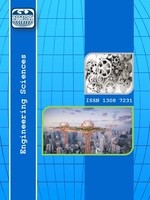BİYOFİLM OLUŞUMUNUN GALVANİZLİ ÇELİĞİN BİYOKOROZYONUNA ETKİSİNİN ELEKTROKİMYASAL YÖNTEMLERLE İNCELENMESİ
Bu çalışmanın amacı, model su sirkülasyon sistemindeki galvanizli çelik yüzeylerde oluşan ve karışık bakteri populasyonu içeren biyofilmin morfolojisini, yapısını ve direncini elektrokimyasal yöntemler ile incelemek ve olgunlaşma sürecindeki biyofilmin galvanizli çeliğin korozyonuna olan etkisini belirlemektir. Gerçek bir soğutma kulesini simüle eden model su sirkülasyon sistemi 3 ay boyunca kesintisiz olarak çalıştırılmıştır. Her ay sistemden çıkarılan kuponların yüzeyinde oluşan biyofilmin direnci, elektrokimyasal impedans spektroskopisi (EIS) yöntemi uygulanarak belirlenmiş ve kuponların polarizasyon eğrileri çizilmiştir. Oluşan biyofilm tabakası ve korozyon ürünleri, taramalı elektron mikroskobu (SEM) ile incelenmiştir. Sonuç olarak, galvanizli çelik yüzeylerde oluşan biyofilmin yapısının ve direncinin maruz kalma sürelerine göre farklılık gösterdiği ve bu durumun metalin korozyon davranışını değiştirdiği tespit edilmiştir.
Anahtar Kelimeler:
Biyofilm, Galvanizli Çelik, Mikrobiyolojik Korozyon, Elektrokimyasal Yöntemler, Soğutma kulesi
___
- 1. Kazanç, A., (1992). Soğutma kuleleri. Yayımlanmamış Yüksek Lisans Tezi. İstanbul: Yıldız Teknik Üniversitesi Fen Bilimleri Enstitüsü.
- 2. Choudhary, S.G., (1998). Emerging Microbial Control Issues in Cooling Water Systems, Hydrocarbon Processing, 77 (5), 91-102.
- 3. Characklis, W.G., (1981). Fouling Biofilm Development: A Process Analysis, Biotechnology And Bioengineering, 23, 1923-1960.
- 4. Puckorius, P.R., (1999). Water Corrosion Mechanism, ASHRAE Journal, 41(5), 57-61.
- 5. Lebrinia, M., Traisnela, M., Gengembreb, L., Fontainea, G., Leraslec, O., and Genet, N., (2011). Electrochemical Impedance Spectroscopy and X-Ray Photoelectron Spectroscopy Study of The Corrosion Behaviour of Galvanized Steel and Electroplating Steel, Applied Surface Science, 257, 3383–3387.
- 6. Abdoli, L., Huang, J., and Li, H., (2016). Electrochemical Corrosion Behaviors of Aluminum-Based Marine Coatings in The Presence of Escherichia coli Bacterial Biofilm, Materials Chemistry and Physics, 173, 62-69.
- 7. Zhang, X.G., (1996). Corrosion and Electrochemistry of Zinc. New York: Plenum Press.
- 8. Minnoş, B., Ilhan-Sungur, E., Çotuk, A., Doğruöz-Güngör, N., and Cansever, N., (2013). The Corrosion Behaviour of Galvanized Steel in Cooling Tower Water Containing A Biocide and A Corrosion İnhibitor, Biofouling, 29(3), 223-235.
- 9. Crombie, D.J., Moody, G.J., and Thomas, J.D.R., (1984). Corrosion of Mild Steel Under Diesel Oil By Sulphate-Reducing Bacteria, Materials Chemistry and Physics, 10, 91-105.
- 10. Campanac, C., Pineau, L., Payard, A., Baziard-Mouysset, G., and Roques, C., (2002). Interactions Between Biocide Cationic Agents and Bacterial Biofilms, Antimicrobial Agents and Chemotherapy, 46, 1469.
- 11. Donlan, R.M., (2002). Biofilms: Microbial Life On Surfaces, Emerging Infectious Diseases, 8(9), 881.
- 12. Ilhan-Sungur, E., Unsal-Istek, T., and Cansever, N., (2015). Microbiologically Influenced Corrosion of Galvanized Steel By Desulfovibrio sp. and Desulfosporosinus sp. in The Presence of Ag-Cu Ions, Materials Chemistry and Physics, 162, 839.
- 13. Unsal, T., Ilhan-Sungur, E., Arkan, S., and Cansever, N., (2016). Effects of Ag and Cu ions On The Microbial Corrosion of 316L Stainless Steel in The Presence of Desulfovibrio sp., Bioelectrochemistry, 110, 91.
- 14. Huabing, Li., Zhou, E., Zhang, D., Xu, D., Xia, J., Yang, C., Feng, H., Jiang, Z., Li, X., Gu, T., and Yang, K., (2016). Microbiologically Influenced Corrosion of 2707 Hyper-Duplex Stainless Steel By Marine Pseudomonas Aeruginosa Biofilm, Scientific Reports, 6, 1-12.
- Başlangıç: 2009
- Yayıncı: E-Journal of New World Sciences Academy
Sayıdaki Diğer Makaleler
FOSFAT VE SİLİKAT KAPLANMIŞ ÇİNKONUN KOROZYONUNA ANİLİN VE Ce+3’ÜN ETKİSİ
DERYA ALTUĞ, TURAN YANARDAĞ, ALİ ABBAS AKSÜT
AGE AND EXPERIENCE BASED NEUROCOGNITIVE PERFORMANCE OF SEAFARERS
Umut TAÇ, Leyla TAVACIOĞLU, Pelin BOLAT
Tuba ÜNSAL, Esra ILHAN-SUNGUR, Nurhan CANSEVER
Emin USLU, Recep ÇATAR, Murat ÇOLAK
TiB2-B4C KOMPOZİT TOZLARININ KARBÜR BORLAMA YÖNTEMİYLE ÜRETİLMESİ
